【OUR TOWN學生團隊成員 杜巖智報導】
蓮池潭
大家知道嗎?蓮池潭其實原本叫「蓮花潭」,位在高雄左營區的東側,剛好在縱貫鐵路和高屏溪之間。這裡有個很大的湖面,大約42公頃,旁邊還有龜山和半屏山,景色挺特別的。早在清朝時,這裡因為夏天盛開的荷花和蓮花被叫做「泮水荷香」,荷花的香氣飄散四周,成為當時鳳山八景之一。特別是傍晚,夕陽下的湖面倒映著半屏山和龍虎塔,有一種靜謐的氛圍。
如果來蓮池潭,可以去西岸走一走,像是慈濟宮、龍虎塔、春秋閣、啟明堂、元帝廟,幾乎都在這一帶。另外這裡還有規劃好的環湖道路和自行車道,沿途可以看看古老的廟宇和一些綠意盎然的風景,散步或騎車都挺不錯。
十月中旬的「萬年季」是蓮池潭一年一度的活動,當中比較有特色的部分是慈濟宮的「迎火獅」祈福活動。除了活動本身,現場還有不少在地小吃,是體驗左營地方文化的機會。
Lotus Pond
Did you know? Lotus Pond was originally called "Lotus Flower Pond." It’s located on the eastern side of Zuoying District in Kaohsiung, nestled between the main north-south railway line and the Gaoping River. The pond spans a large area of about 42 hectares and is surrounded by Guishan (Turtle Mountain) and Banpingshan (Half-Screen Mountain), creating a unique and picturesque landscape. Back in the Qing Dynasty, the area was renowned for the lotus and water lilies blooming in summer, earning it the name "Fragrant Waters of the Lotus." The floral scent would waft across the surroundings, making it one of the "Eight Sights of Fengshan." Especially at dusk, the lake reflects Banpingshan and the Dragon and Tiger Pagodas in the sunset, creating a tranquil atmosphere.
If you visit Lotus Pond, you can take a walk along its western shore, where landmarks like Ciji Temple, the Dragon and Tiger Pagodas, Spring and Autumn Pavilions, Qiming Hall, and Yuan Di Temple are all located. The area also features well-designed lakeside roads and bike paths. Along the way, you can enjoy views of ancient temples and lush greenery, making it a great spot for walking or cycling.
Every year in mid-October, Lotus Pond hosts its annual "Wannian Festival." One of the event's highlights is the "Fire Lion Welcoming" blessing ceremony at Ciji Temple. In addition to the festivities, there are plenty of local snacks available, offering a chance to experience Zuoying’s local culture.
慈濟宮
你知道嗎?當地人親切地稱這座廟為「老祖廟」,它位於高雄市左營區的蓮池潭畔,建於西元1719年之前,到現在已有300多年的歷史呢!這座廟主祀的是保生大帝,他可是台灣早期居民渡海來台的重要守護神之一哦!當時的開墾者為了祈求平安,從家鄉帶來這位家神,慢慢地由個人家神演變成了庄頭共同的信仰。保生大帝在民間信仰中,就像是古早版的「家庭醫師」,大家到慈濟宮都可以看到虔誠的信眾,為家人健康祈求平安。不僅如此,除了現代醫學的幫助,保生大帝還帶給大家一種心理寄託,幫助病患勇敢面對病情,甚至成為醫生們的守護神呢!下次有機會來左營,記得到老祖廟走一趟,感受這份信仰的力量吧!
Ciji Temple
Did you know? Locals affectionately call this temple the "Old Ancestral Temple." It is located by the Lotus Pond in Zuoying District, Kaohsiung City, and was built before 1719, making it over 300 years old! The temple is dedicated to Poh Seng Tai Tay, one of the key guardian deities for early Taiwanese settlers who crossed the sea to Taiwan. Back then, pioneers brought this deity from their hometown as a family god to pray for safety. Over time, the family deity evolved into a shared belief within the community.
In folk religion, Poh Seng Tai Tay is like an ancient version of a "family doctor." At Ciji Temple, you can always see devout worshippers praying for their family's health and well-being. Not only that, in addition to the help of modern medicine, Poh Seng Tai Tay provides people with spiritual comfort, helping patients face their illnesses bravely and even becoming a protector for doctors. The next time you visit Zuoying, make sure to stop by the Old Ancestral Temple and feel the power of this enduring faith!
信眾們透過拜拜來向保生大帝祈求心願,而祈求的方式可是多種多樣的哦~
香是最常見的一種方式,因為煙霧向上升騰,象徵著將心願傳達到天上!人們會手持香枝虔誠祈禱,將心中的願望向保生大帝訴說,祈求神明的庇佑與傾聽。在廟宇中,你常常可以看到信眾焚香拜拜,然後將香插入香爐中,這代表著心願已成功傳遞給神明啦!每一炷香,都是信眾滿滿的誠意與祈求喔~
筊杯是民間信仰與道教中非常重要的一種尋求神明指示的工具,相信很多人都對這個儀式不陌生吧!筊杯有正反面,平坦的部分稱為 「陽面」(正面),凸起的部分則叫做 「陰面」(反面)。根據筊杯落下的組合,可以解讀出神明的指示喔~
聖杯:一正一反,代表神明同意、贊同或認可所祈求的事情,簡單來說就是「好,這樣可以!」
無杯:兩隻都是反面,表示神明不認同、不應許,或許是時機未到呢~
笑杯:兩隻都是正面,這就有趣了!代表神明笑而不答,可能是你問得不夠清楚,或者事情自有定數,無需再多問喔!
筊杯是一種與神明溝通的特別方式,每一次擲筊都是在向神明表達誠意~
Worshippers pray to Poh Seng Tai Tay to express their wishes, and there are many different ways to do so!
The incense sticks is the most common way of prayer, because the rising smoke symbolizes sending wishes up to the heavens! People hold incense sticks and worship sincerely, expressing their wishes to Poh Seng Tai Tay and seeking the deity's protection and guidance. In temples, you often see worshippers burning incense and then placing the sticks into the incense burner, signifying that their wishes have successfully been conveyed to the deity. Each stick of incense represents the worshippers' heartfelt sincerity and prayers!
The moon blocks, or "Jiao Bei," are an important tool in folk religion and Taoism for seeking guidance from the gods. Many people are likely familiar with this ritual! The Jiao Bei have two sides: the flat side is called the "yang side" (front), while the rounded side is referred to as the "yin side" (back). By interpreting the combination of how the blocks land, one can decipher the instructions or messages from the gods!
Divine answer: One upright and one reversed, representing the divine's agreement, approval, or acknowledgment of the requested matter. In simple terms, it means "Okay, this is fine!"
No answer: Both are reversed, indicating that the divine does not approve or grant permission, perhaps the timing is not right yet.
Laughing answer: Both are upright, and this is interesting! It means the divine smiles but does not answer. Perhaps your question wasn't clear enough, or the matter is already predestined, so there's no need to ask further.
Jiao Bei are a special way of communicating with the divine. Each time you cast the Jiao Bei, it is a way of expressing sincerity to the gods.
運籤是民間信仰中非常常見的一種求問方式,用來向神明請示自己的運勢或未來的方向~當信眾抽出一支運籤時,籤上會標有編號,接著你就可以到籤詩櫥找到對應的籤詩啦!籤詩通常是七言絕句,內容可能引用歷史人物的故事、民間傳說,或者前人詩詞,用來傳達神明的指示,例如吉凶禍福、未來的注意事項等。但!抽中籤詩後可別急著解讀,通常會再搭配筊杯,請示神明這支籤是否正確,確保指示與自己的問題相符哦~運籤不僅是一種傳統文化,也是與神明溝通的重要橋梁!
藥籤是藉由神明的力量來診斷病情、治療疾病的藥單哦!流程也很特別~
第一步:點三炷香,虔誠地向保生大帝稟報自己的症狀,記得要說清楚唷!
第二步:將三炷香輕輕靠在手腕的脈上,這個動作象徵著請神明「把脈」,是不是很神聖呢?
第三步:等到三炷香的香灰各掉一次後,前往對應的科目籤筒抽籤。
第四步:抽到籤後,把籤詩放在案桌上擲筊,得到聖筊(正確的神明指示)後就可以前往籤櫃領取藥籤啦!
最後一步:根據藥籤上的提示,配出對應的中藥材。
是不是覺得既有趣又有文化意義呢?有機會一定要親身體驗看看喔~
The drawing divination sticks is a very common method in folk beliefs for seeking guidance from deities about one’s fortune or future direction. When a devotee draws a divination stick, the stick will have a number written on it. With this number, you can find the corresponding divination poem in the poem cabinet. These divination poems are usually written in the form of seven-character quatrains. They may reference historical figures, folk legends, or classical poetry to convey the deity’s message, such as indications of good or bad fortune, warnings, or future considerations.
However, don’t rush to interpret the divination poem as soon as you draw it! It’s customary to pair this with the use of "Jiao Bei" to confirm with the deity whether the drawn stick is correct, ensuring the guidance aligns with your question.
The drawing divination sticks is not only a traditional cultural practice but also an important bridge for communicating with the divine!
The medicine divination sticks are prescriptions believed to diagnose illnesses and provide treatments through the power of deities. The process is quite unique and sacred! Here’s how it works:
First Step: Light three incense sticks and sincerely report your symptoms to the Poh Seng Tai Tay. Make sure to describe them clearly!
Second Step: Gently place the three incense sticks on your wrist, symbolizing the deity “taking your pulse.” Isn’t that profound?
Third Step: Once the ashes from each incense stick fall once, go to the divination stick container for the corresponding medical department and draw a stick.
Fourth Step: After drawing the stick, place the divination poem on the table and use “Jiao Bei” (筊杯) to confirm the guidance. If you receive a sacred sign (聖筊), you can proceed to the cabinet to collect your medicine stick!
Final Step: Follow the instructions on the medicine stick to prepare the corresponding traditional Chinese herbal medicine.
Isn’t it both fascinating and culturally meaningful? If you ever have the chance, be sure to experience it for yourself!
走進慈濟宮,牆上那一整面的光明燈超吸睛吧!這可不是普通的燈具哦~它是道教中用來祈福的專屬燈具,充滿了滿滿的祝福與祈願~每層燈座都有許多小隔間,裡頭放著紅色的小燈泡,外面則是透明的小窗,上面寫著或貼著施主的姓名和生日,通常是用紅色筆書寫,這樣看起來特別喜氣又充滿能量呢!光明燈的費用不僅象徵著祈福的心意,也是慈濟宮重要的香火錢來源,支持宮廟的運作和發展哦!
Stepping into the Ciji Temple, the wall filled with Guangming Lanterns is truly captivating! These are no ordinary lamps—they are special lanterns in Taoism used for blessings, brimming with good wishes and prayers. Each tier of the lantern structure contains numerous small compartments, housing red light bulbs. On the outside, there are transparent windows with the donor's name and birthdate written or attached, usually in red ink, symbolizing joy and positive energy.
The fee for lighting a Guangming Lantern not only represents the devotee’s heartfelt prayers but also serves as an important source of incense funds for the temple, supporting its operations and development.
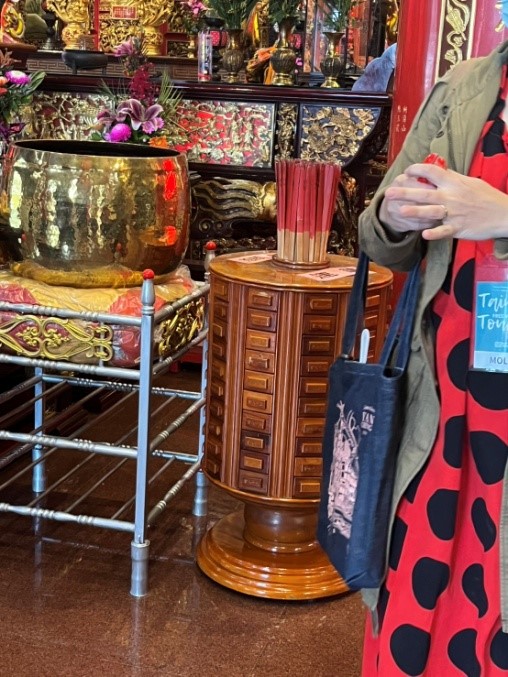
運籤是用來向神明請示未來的吉凶禍福(杜巖智 攝影)
The drawing divination sticks is a method used to seek guidance from deities about future fortunes and misfortunes.
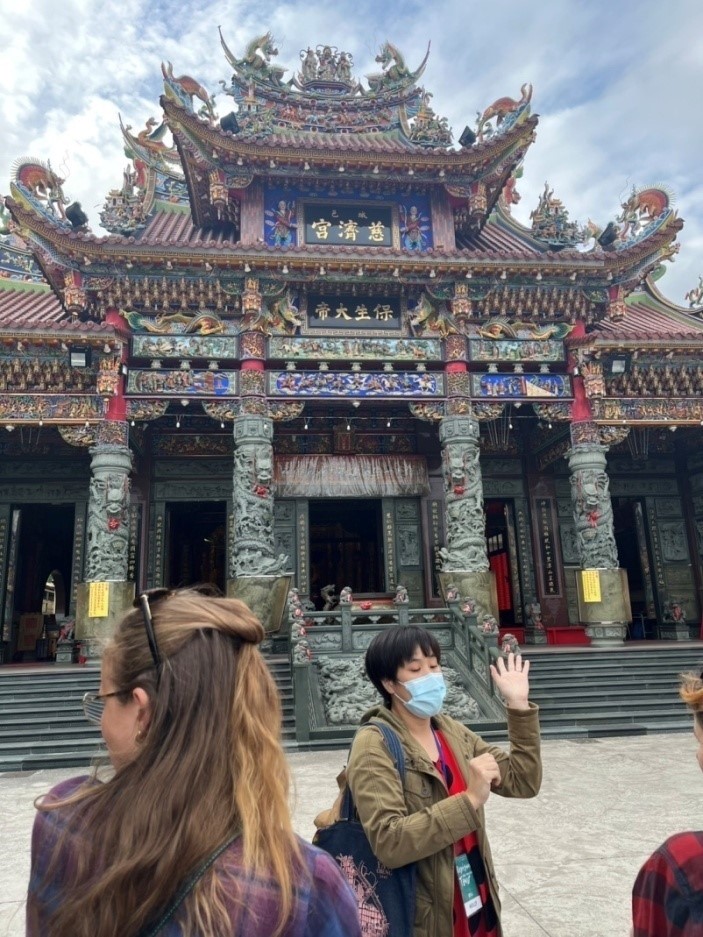
導遊Molly正在介紹左營慈濟宮(杜巖智 攝影)
Molly introduced the Ciji Temple.
龍虎塔
位於高雄市左營區蓮池潭畔的龍虎塔,是當地最具代表性的地標之一,不僅風景優美,還蘊藏著豐富的歷史故事。
1974年,左營慈濟宮的保生大帝降駕,指示將有災難來臨,信徒們為了祈求平安,依照神明的指示開始興建龍虎塔。在信眾齊心支持下,龍虎雙塔於1976年順利完工。左營慈濟宮常務監察委員陳榮隆透露,塔落成後的隔年果然有賽洛瑪颱風來襲,讓人不禁聯想到保生大帝的神準預言。此外,也有說法認為建造龍虎塔是為了補救因「永清塔」對當地風水造成的影響。龍虎塔高達七層,設計充滿巧思。參觀時需按照規矩「龍口進、虎口出」,象徵「入龍喉、出虎口」,這樣才能趨吉避凶。塔內還有交趾陶的勸世故事壁畫,皆出自名家之手,細節之精緻令人讚嘆。塔身與九曲橋交相輝映,倒映在蓮池潭的湖面上,構成一幅美麗畫面。而登上塔頂,更能將蓮池潭的迷人全貌盡收眼底,景色絕對令人驚艷。
來到蓮池潭,龍虎塔絕對是你不能錯過的亮點!不僅能感受濃厚的文化氣息,還能欣賞高雄的絕美景色。
Dragon and Tiger Pagodas
The Dragon and Tiger Pagodas, located on the banks of Lotus Pond in Zuoying District, Kaohsiung City, are one of the most iconic landmarks in the area. Not only do they offer stunning scenery, but they are also rich in historical stories.
In 1974, the Poh Seng Tai Tay of Zuoying's Ciji Temple descended to deliver a prophecy, warning of an impending disaster. To pray for safety, the devotees, following the deity's guidance, began constructing the Dragon and Tiger Pagodas.
Thanks to their collective efforts, the twin pagodas were successfully completed in 1976. According to Chen Ronglong, a standing supervisor of Ciji Temple, the following year, Typhoon Selem indeed struck the area, leading many to marvel at the deity’s accurate prophecy. Additionally, some believe the construction of the pagodas was meant to counteract the negative impact on local feng shui caused by the nearby Yongqing Pagoda.
The Dragon and Tiger Pagodas stand seven stories tall and are full of thoughtful design. Visitors must follow the custom of entering through the dragon’s mouth and exiting through the tiger’s mouth, symbolizing "entering the dragon's throat and exiting the tiger's mouth" to bring good fortune and avoid bad luck. Inside the pagodas, you can admire intricate ceramic murals that tell moral tales, crafted by renowned artisans with exceptional attention to detail. The pagodas, along with the Nine-Bend Bridge, are reflected beautifully on the surface of Lotus Pond, creating a picturesque scene.
Climbing to the top of the pagodas offers a breathtaking panoramic view of the enchanting Lotus Pond landscape.
When visiting Lotus Pond, the Dragon and Tiger Pagodas are an unmissable highlight! They not only immerse you in a rich cultural atmosphere but also provide the opportunity to admire Kaohsiung’s stunning natural beauty.
在龍虎塔入口處,有一隻龍首龜身的靈獸鎮守著,這可是有名的風水寶物「龍龜」,也叫「贔屭」。它外形像龜,但頭部是威風的龍首,整體以青石雕刻而成,位置正對著龍虎塔的出入口,看起來威嚴又大氣。
龍龜在傳說中是龍的九子之一,力氣大、好負重,因此常被用來支撐石碑底座,也象徵穩固與長久。在風水上,龍龜被認為能擋煞招財,背部的圓方錢和元寶裝飾就是其招財作用的具體象徵。而將龍龜擺放在龍虎塔前,還取了「榮歸」的諧音,充滿吉祥寓意。據說,龍龜不僅能化解太歲、歲破等煞氣,還有助於增強人緣,吸引貴人,甚至廣納福祿和正財。
在民間傳說中,觸摸龍龜的龍首或龜身,能為自己帶來更多福氣。下次造訪龍虎塔,別忘了靠近這隻靈獸,感受它的守護力量,也為自己祈求好運和平安。
At the entrance of the Dragon and Tiger Pagodas stands a mystical creature with the body of a turtle and the head of a dragon, known as the Dragon Turtle or "Bixi". This famous feng shui artifact, carved from green stone, exudes an aura of grandeur and majesty as it faces directly toward the entrance of the pagodas.
The Dragon Turtle is one of the nine sons of the dragon in Chinese mythology. Renowned for its strength and ability to bear heavy loads, it is often used as the base of stone steles, symbolizing stability and longevity. In feng shui, the Dragon Turtle is believed to ward off negative energy and attract wealth. Its back is adorned with round coins and ingots, which visually represent its role in drawing prosperity. Placing the Dragon Turtle in front of the Dragon and Tiger Pagodas also carries the auspicious pun of "Róng Guī", meaning "glorious return."
Legend has it that the Dragon Turtle can dissolve harmful energies, such as those associated with Tai Sui (the Grand Duke Jupiter) or other annual conflicts, while also enhancing social connections, attracting benefactors, and bringing good fortune and wealth.
In folklore, touching the dragon’s head or the turtle’s shell is said to bring blessings and good luck. Next time you visit the Dragon and Tiger Pagodas, don’t forget to approach this mystical guardian, feel its protective energy, and make a wish for luck and peace in your life!
啟明堂
啟明堂,也就是我們熟悉的武廟,是一座充滿儒道釋三教合一精神的儒宗神教廟宇,這裡供奉著三教聖人,主祀文聖孔子與武聖關公,並配祀岳飛與鄭成功。這樣的組合,是不是覺得相當有文化意義呢?
這座廟宇創建於光緒25年(西元1899年),位於蓮池潭的西南方。外觀採用東方宮殿式建築風格,壯麗堂皇,氣勢非凡,每一個細節都充滿歷史韻味。每逢諸神的誕辰,啟明堂便成為熱鬧非凡的中心,信眾們作醮迎神,隆重敬拜。這些祭典不僅是地方的重要宗教活動,也展現了深厚的民俗文化傳承。來到蓮池潭,別忘了到啟明堂走走,不僅能感受它的莊嚴氣息,還能了解更多地方特色與傳統文化。
Chi Ming Palace
Chi Ming Palace, also known as the Martial Temple, is a shrine that embodies the spirit of the unity of Confucianism, Taoism, and Buddhism. This temple honors the sages of the three teachings, with its main deities being Wen Sheng Confucius and Wu Sheng Guan Gong, accompanied by Yue Fei and Zheng Chenggong. This unique combination carries profound cultural significance, doesn’t it?
Founded in 1899 (the 25th year of the Guangxu Emperor’s reign), Chi Ming Palace is located on the southwestern side of Lotus Pond. Its exterior adopts the architectural style of an Eastern palace, majestic and grand, with every detail steeped in historical charm. During the birthdays of its deities, the hall becomes the lively focal point of celebrations, with devotees performing rituals, welcoming the gods, and offering solemn worship. These ceremonies are not only important religious events but also showcase the rich heritage of local folk traditions.
When visiting Lotus Pond, don’t forget to stop by Chi Ming Palace. You’ll not only experience its solemn atmosphere but also gain a deeper appreciation for the region’s unique cultural and traditional heritage.
走上二樓,可別錯過這裡的特色空間!二樓設有「中華文物民俗館」,讓人一秒穿越時光,感受傳統文化的魅力。不僅如此,這裡還特別設有社區讀書中心,提供附近的學子們一個舒適的研讀環境,還能翻閱各類書報,充滿濃濃的人文氣息。
如果想放鬆片刻,外頭的中庭魚池就是個好去處,靜靜欣賞魚兒悠遊水中的景象,讓人感覺身心都被療癒了!
四樓可是個相當重要的地方!這裡是「凌霄寶殿」,供奉玉皇上帝等多位神祇,充滿莊嚴與神聖的氛圍。一走進來,立刻能感受到那份神靈庇佑的力量。
Upon reaching the second floor, don't miss out on its unique space! The second floor houses the "Chinese Cultural Relics and Folk Museum," where you can instantly travel through time and experience the charm of traditional culture. In addition, there is a community reading center, providing a comfortable study environment for local students. It also offers a variety of books and magazines, filling the space with a strong cultural atmosphere.
If you want to relax for a moment, the courtyard's fish pond outside is a perfect spot. Watching the fish swim gracefully in the water offers a calming experience, making you feel both mentally and physically rejuvenated!
The fourth floor is a particularly significant place! This is the Lingxiao Hall, dedicated to the Jade Emperor and several other deities, exuding a solemn and sacred atmosphere. Upon entering, you can immediately feel the divine presence and the power of the gods' protection.
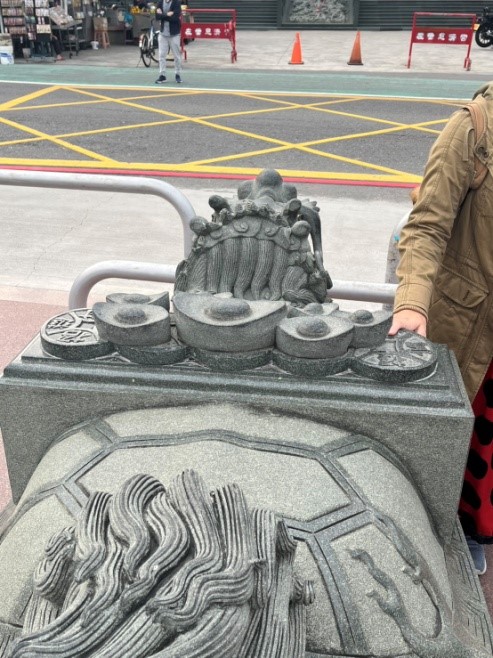
為龍龜背後的財寶,傳說觸摸可帶來財運(杜巖智 攝影)
The image displays the treasure on its back. According to legend, touching these treasures can bring good fortune and wealth.
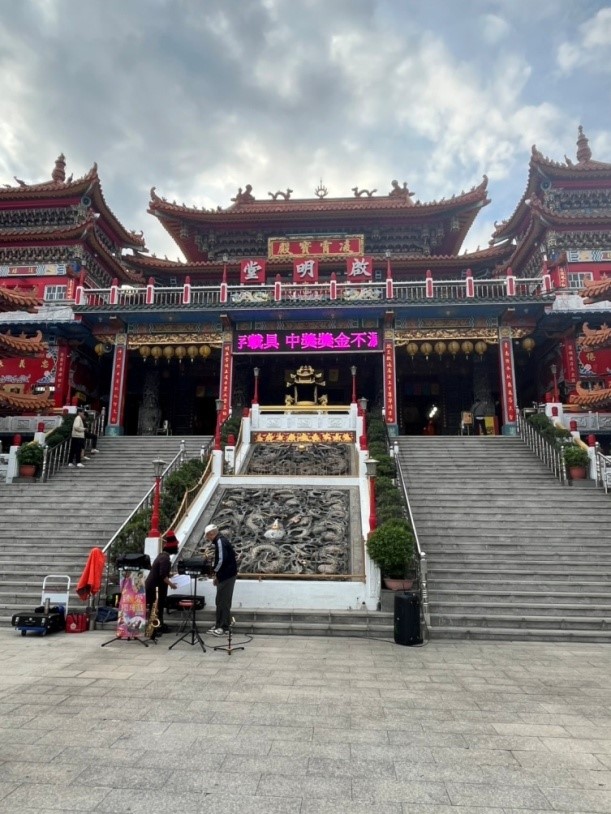
位於左營蓮池潭旁的啟明堂(杜巖智 攝影)
Located beside Lotus Pond in Zuoying, Chi Ming Palace.
春秋閣
蓮池潭旁邊的春秋閣可是個老地方了,早在1953年就蓋好,到現在已經超過60歲啦!它有兩座樓閣,一座叫「春閣」,另一座叫「秋閣」,這名字是向孔子的《春秋》致敬的。樓閣的設計很有特色,四層八角形,綠色屋瓦配上黃色牆面,倒映在水面上,還跟九曲橋連在一起,整個畫面很有古早味。
這地方是為了紀念關公建的,也有人叫它「春秋御閣」。裡面還有個龍形隧道,走進龍口後,可以看到牆上有好多五顏六色的畫,講的是一些宗教故事,畫得很細緻,可以邊走邊看~
另外,春秋閣前面還有一尊騎龍觀音像,傳說這尊像是照著觀音菩薩曾經騎龍現身的樣子建的。當時菩薩還特別指點信徒說要建在這裡,現在這尊雕像就站在春閣和秋閣中間,看著就覺得挺有故事感。
Spring and Autumn Pavillions
The Spring and Autumn Pavilions by Lotus Pond are truly a classic spot! Built back in 1953, they are now over 60 years old. The site features two pavilions, one named "Spring Pavilion" and the other "Autumn Pavilion," as a tribute to Confucius' Spring and Autumn Annals. These pavilions have a unique architectural design, with four-story octagonal shapes, green-tiled roofs, and yellow walls. Their reflection on the water, along with the connecting zigzag bridge, creates a charming, nostalgic scene.
The pavilions were built to honor Guan Yu, and some also call them the "Imperial Pavilions of Spring and Autumn." Inside, there’s a dragon-shaped tunnel, where visitors can enter through the dragon's mouth. The walls are adorned with vibrant, detailed paintings depicting various religious stories, offering plenty to admire as you walk through.
In addition, in front of the Spring and Autumn Pavilions stands a statue of Guanyin riding a dragon. According to legend, this statue was modeled after an appearance of the Bodhisattva riding a dragon. It’s said that Guanyin specifically instructed devotees to build it here. Now, the statue stands between the two pavilions, adding an air of mystique and storytelling to the site.
元帝廟
左營的元帝廟是左營早期信仰的一大據點,最一開始是在1666年,也就是明鄭永曆二十年,搭了一個簡單的草寮,專門供奉守護神臨水夫人媽。聽說她可是最早來到左營的神明,後來又有福德正神和朱府千歲一起加入「團隊」。因為朱府千歲的地位比較高,廟裡的主祀神就換成了他。到1714年的時候,廟終於動工蓋起來,三年後完工,總算有了一座比較正式的廟宇。
然後故事就來了!乾隆和嘉慶年間,有位漁民在萬丹港捕魚時,意外撈到玄天上帝的神像,從此他的捕魚事業順風順水,滿載而歸成了日常。這件事傳開後,玄天上帝的名聲也越來越響亮,當地人還商量著把祂請進廟裡當主祀神,廟名也跟著改成了「北極大帝廟」。
元帝廟這一路走來,修修補補也不少,最後一次大翻新是在1972年,大家日子過得好了,就把廟重建了一次,變成了現在看到的模樣。這地方不只是廟,還藏著很多的故事,每個角落都像在悄悄告訴你左營以前的生活樣子,有著濃厚的歷史氣息。
Yuan Di Temple
The Yuan Di Temple in Zuoying has been a major center of faith in the area since its early days. It all began in 1666, during the 20th year of the Yongli reign in the Ming Zheng period, when a simple straw hut was built to honor the guardian deity, Mazu, also known as Linshui Furen. It’s said that she was the first deity to arrive in Zuoying. Later, the Earth God and Zhu Fu Qiansui joined the “team.” Since Zhu Fu Qiansui held a higher status, he eventually became the temple’s primary deity. By 1714, construction on a more formal temple began, and three years later, it was completed, finally giving the community a proper place of worship.
Then came the legend! During the Qianlong and Jiaqing reigns, a fisherman in Wandan Port accidentally caught a statue of Xuantian Shangdi while fishing. From that point on, his fishing ventures were smooth and successful, with bountiful catches becoming the norm. Word of this spread quickly, and Xuantian Shangdi’s reputation grew. The locals decided to enshrine Him as the temple’s primary deity, renaming the temple “Beiji Dadi Temple.”
Over the years, Yuan Di Temple underwent several renovations. The most significant reconstruction took place in 1972, as the community’s improved living conditions allowed them to rebuild the temple into its current form. Today, the temple is more than just a place of worship; it’s a treasure trove of stories. Every corner seems to quietly tell tales of life in Zuoying’s past, brimming with a rich sense of history.
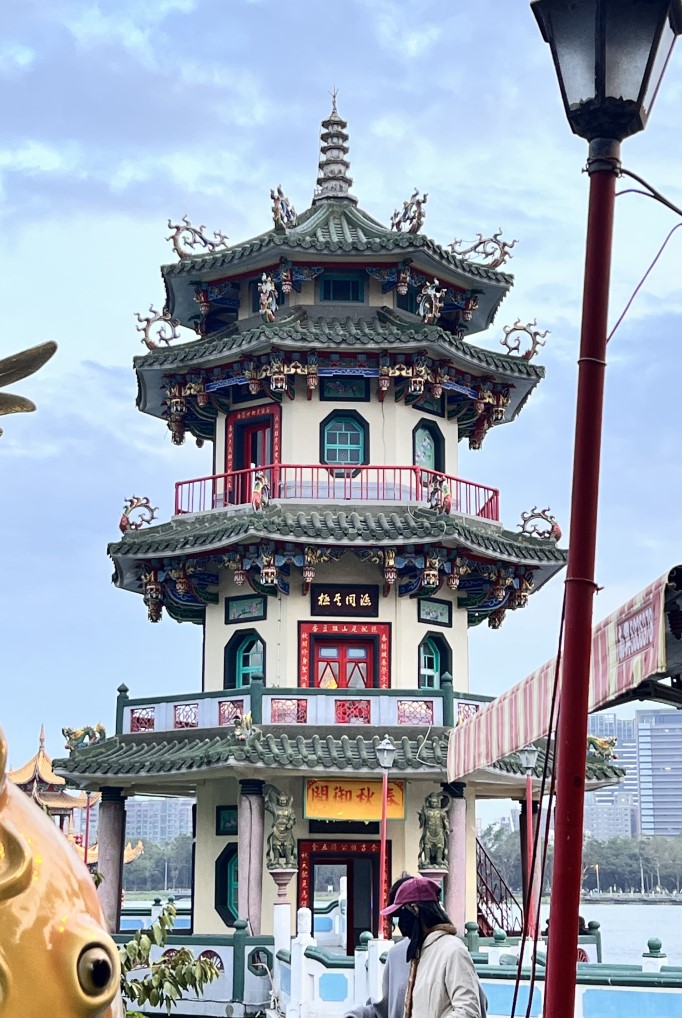
春秋御閣(杜巖智 攝影)
The image shows the Imperial Pavilions of Spring and Autumn.
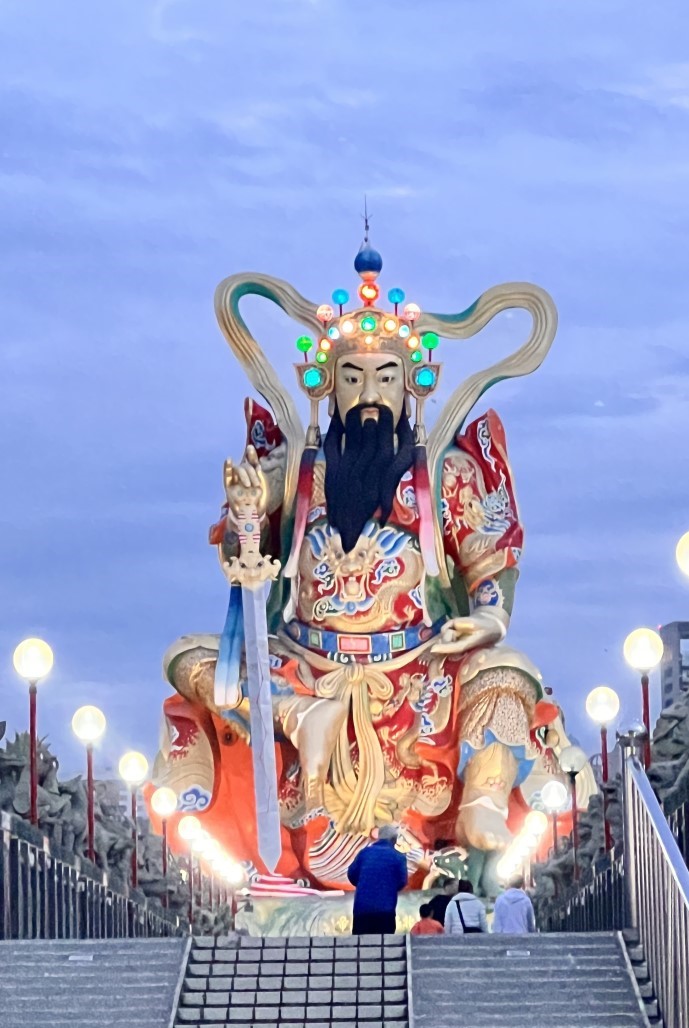
北極玄天上帝塑像(杜巖智 攝影)
The Statue of Xuantian Shangdi of the North Pole.
